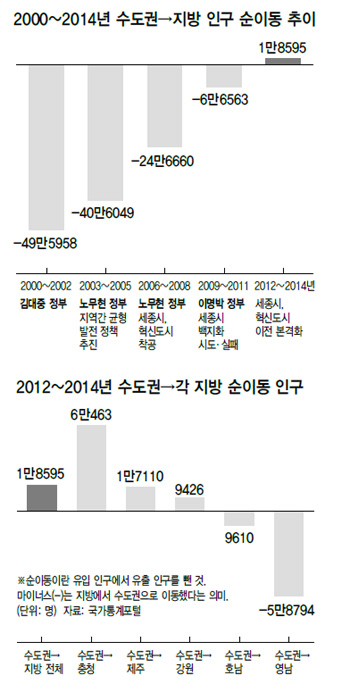As policies take effect, migratory trends leading away from the Seoul area
Nationwide, young people continue to move to Seoul, while more baby boomers leaving the big city
Net population movements have begun shifting away from the greater Seoul area as balanced regional development policies launched during the Roh Moo-hyun administration have started taking effect.
The Roh administration (2003-08) launched the policies, which included the building of a multipurpose administrative city at Sejong and numerous “innovation cities,” with the goal of achieving a net migration of 1.7 million people out of the greater Seoul area (the cities of Seoul and Incheon and surrounding Gyeonggi Province) between 2012 and 2030.
A Mar. 3 analysis of population movement trends by the Hankyoreh using data from the Korean Statistical Information Service (KOSIS) showed a net migration of 18,595 people away from the greater Seoul area over the three years between 2012, when government institutions and their associated agencies were first moved to Sejong and the ten innovation cities, and 2014. “Net migration” refers to number of incoming residents minus the number of residents leaving. In 2012, the net migration was 6,900 toward the greater Seoul area and away from the rest of the country (known locally as “the provinces”). By 2013, the provinces had a net influx of 4,384 people. The following year, it was up to 21,111.
While the size of the population shift out of the greater Seoul area is still only around 20,000 people, the trend is still noteworthy. Before 2012-14, the trend had been forty uninterrupted years of net population movements out of the provinces toward the capital region. The provinces suffered net population losses of 66,563 people in 2009-11, 246,660 in 2006-08, 406,049 in 2003-05, and 495,958 in 2000-02.
The Chungcheong region was the largest beneficiary of migration over the past three years, with a net population increase of 60,463 from the greater Seoul area: 24,898 to South Chungcheong Province, 21,979 to Sejong, and 14,379 to North Chungcheong Province. The city of Daejeon suffered a net loss of 793 to greater Seoul.
“The main reasons for the population movements toward Chungcheong appear to be the construction of Sejong, a trend of people returning to agriculture and village life, and industrial complexes in northern South Chungcheong,” said Kang Hyun-soo, director of the Chungnam Development Institute.
The original target population influx for Chungcheong was 650,000 Seoul-area residents by 2030.
Jeju Island and Gangwon Province had the next largest net influxes of greater Seoul residents. Jeju attracted 17,100 people from the capital region over three years, ranking it third only to South Chungcheong and Sejong.
“It appears that Jeju is one of the more attractive destinations for people who are looking for a better quality of life in the ‘US$30,000 [per capita GNP] era,’” said Kwon Yong-woo, an emeritus professor at Sungshin Women‘s University.
Gangwon Province, which is a popular destination for returning farmers, saw a net influx of 9,426 people from the Seoul area over the three-year period.
For the Yeongnam and Honam regions (the southeast and southwest of the country, respectively), the net population loss to Seoul continues. The five metropolitan cities and provinces in Yeongnam experienced a net loss of 58,794 residents to the capital region between 2012 and 2014. Analysts blamed the continued decline on a slump among major local manufacturers. The balanced development policy set its initial target net population gain for Yeongnam at 720,000 Seoul-area residents by 2030.
In Honam, the net population loss to the Seoul area has been 9,610 people since 2012. The net outflow has been shrinking, however, with a decline from 5,853 in 2012 to 3,079 in 2013 and just 678 in 2014. Gwangju had the largest net loss, with 8,596 residents; North Jeolla Province had a net loss of 1,700. South Jeolla Province, in contrast, had a net gain of 686 Seoul-area residents - suggesting the balanced development policies have had some effect. The initial target population influx for Honam was 340,000 capital region residents by 2030.
“It hasn’t been very long since Sejong and the innovation cities were built, so the effect has been fairly small,” said Kwon. “Once the infrastructure is established, most of the employees at the relocating agencies will come in, and there could be additional population movements as well.”
Kang noted generational differences present in the population shifts.
“Younger people are still moving to the greater Seoul area, while the baby boomers are moving to the provinces,” Kang explained. “This trend of the older generation moving away from the capital appears likely to continue.”
Dankook University professor Cho Myung-rae suggested a different trend may be at work.
“We’re seeing the entire country turning into one big mega-city,” Cho said. “The trend of greater Seoul residents moving to Chungcheong, Jeju, and Gangwon is less about balanced development than it is about the greater Seoul area growing.”
By Kim Kyu-won, staff reporter
Please direct questions or comments to [english@hani.co.kr]


No comments:
Post a Comment